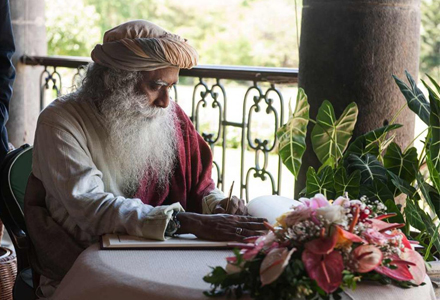Reflecting Nature through Design

“No one can really create anything new here. Anything you create, whether it is a piece of jewelry or clothing, a building, or whatever else, in any form and color, is already somewhere there in nature.”
—Sadhguru
Sadhguru and fashion designer Sabyasachi Mukherjee converse about creativity and design as a reflection of nature.
Acclaimed fashion designer Sabyasachi Mukherjee converses with Sadhguru on beauty, design, fashion and yoga. Here is another excerpt of their stimulating exchange of thoughts, moderated by Arundhathi Subramaniam.
Moderator (Arundhathi Subramaniam): Sabysachi, you’ve talked of imperfection as an integral part of your design. Would you say more about that?
Sabyasachi Mukherjee: In the fashion industry, on one hand, we talk about individuality, and on the reverse, we also talk about mass production. Through advertising, we create an image that if you wear this luxury or fashion product, you are going to stand out. At the same time, we also make ten million pieces of it and manage to put a limited edition tag on it as well.
Sadhguru: Hoping two people with the same dress won’t meet!
Sabyasachi Mukherjee: Yes. I’ve also been a victim of that many times. I design for Indian weddings, and I don’t go to weddings anymore because I’m petrified that three women would be wearing the same outfit. But having said that, I think India can produce something that China cannot. What India can give to you is individuality. When you look at something that is created by hand, in the West, some quality control person is going to reject a piece if it is different from the others. But that is the true spirit of luxury, that things should be different from each other. And only things that are made by hand can be a unique product for a single person – even if it’s a very small difference.
Arundhathi: As an extension of that, I was wondering, given that the creative impulse also entails following a very individual imperative, and then making that meet market demands, how does one walk that very fine line?
Sabyasachi Mukherjee: For an entrepreneur, it’s a little bit of a challenge. When I started, I was labeled as the best thing that happened to India after the sewing machine. And I’ve always thought that the only way you can create iconism is through repetition. So we started doing the same thing over and over again, because mine is a brand that speaks to a slightly older audience. A woman who has probably tried different things, by the time she is thirty-five and she knows what she wants to wear and possibly plans to stick to it for a long time, that is the kind of woman who shops with us. For what we were initially celebrated for, the press started criticizing us after some time, saying, “Same old, same old.” But we stayed true to who we are, and eventually, people started appreciating that again.
I think that when you are an entrepreneur, no amount of forecast and projection can really tell you what’s going to work and what not. It’s your belief and your instinct. If you have a belief system that’s very strong, commerce will automatically follow. I think when you are doing a brand that has a certain aesthetic, it is very important to stay true to your belief system, irrespective of how people perceive you. Eventually, you will win.
Arundhathi: This idea of creativity is linked to the notion of repetition, isn’t it? We sometimes think of repetition only as something that happens in a mass production scenario. But it’s also true that it’s the repetition of the same thing that fuels creativity – not in a mechanistic way. But I think every artist also knows that riyaz (Hindi word for “practice”) and rasa (Sanskrit word for “essence”) come together, don’t they? So I’m wondering if you could expand on this, Sadhguru, because you described chaos as a kind of creativity. Would you say more about repetition and creativity, chaos and design?
Sadhguru: We just have to look at human beings – nobody here has horns, an extra arm, or three eyes – everything is the same, but everything is different. This is creativity. If you want to describe the characteristics of human beings in simple terms – everybody has two legs, two hands, one nose, two eyes, and so on. But just see what a unique happening each one of them is in every way. This is the nature of creation. And no human being should ever think that we are creating something. In some way, knowingly or unknowingly, from the impressions we have taken in, we are reproducing a few things. No one can really create anything new here. Anything you create, whether it is a piece of jewelry or clothing, a building, or whatever else, in any form and color, is already somewhere there in nature.
You have taken in so many impressions, not all of them consciously. Some of these forms and colors and shapes that are there in your mind may find unconscious expression. In this context, when someone says the ashram is beautiful – I didn’t make the mountains, and that’s the most beautiful part of the ashram. They are setting a background, though most people may not notice it. Once it happened, Shankaran Pillai came to the Isha Yoga Center, and he wanted a room with a view. We gave an appropriate room in the Chitra block. Then he complained, reiterating, “I wanted a room with a view.” We said, “This is the room that has the best view.” He said, “The goddamn mountains are in the way.”
This is what has happened to a lot of human beings. They do not see things as they are. Instead, they have ideas. If you want to make something beautiful, the first thing is you shouldn’t have any idea. An idea need not necessarily have anything to do with reality. If instead of having an idea, you have perception, and you simply drink life all the time, if you want to create something or you want to make something happen, it will all be with you – in terms of shapes, forms, colors, sounds, or whatever else. Whether you want to create music, clothing, or a building, if you pay enough attention, it will all be there.
Sabyasachi Mukherjee: May I add something to that, Sadhguru? As a young entrepreneur who wanted to make a mark in the design industry, I wanted to do something that wasn’t there yet – my own design ego, as I would call it. I see the same thing happening in urban architecture today, where everyone wants to leave his mark. No one really preserves and restores. As the brand is getting older, I am looking at this differently. I’m going to give an example. Today, as the political winds have changed, everyone is talking about the revival of Banaras. Banaras doesn’t need to be revived – it just needs to be restored. Many designers, without understanding the ethos of what Banaras is, go and make collections there. Some people just make Kanjeevaram saris in Banaras because it happens to be a cheap weaving hub.
When my design company goes there, I tell them, “The people of Banaras have been designing for hundreds of years. They are the masters. Do not interfere with their work. We are only the medium who will take the design to the market. We are just supposed to restore their market through marketing and advertising.” Because when everyone wants to leave their own mark, design becomes very confusing. And while we talk about the democracy of design, it is also very important to preserve design. I think many of us in India should take the initiative of preserving what we have and what is beautiful, and making people conscious of that reality. At the end of the day, appreciation of beauty is very subjective. If we can just preserve what is beautiful by raising awareness about it, we don’t need to design anymore.
Sadhguru: Those who are very eager to leave footprints will never fly.
Sabyasachi Mukherjee: Sadhguru, as a designer, I have a question for you. I find you an impeccably well-dressed man. You are an example of how Indian men should dress. Who designs your clothes?
Sadhguru: My designs are not going commercial. I don’t want to walk into a conference or a hall where I am going to speak, and everyone is dressed like me! This is all made here locally, within the ashram.
Arundhathi: Sabyasachi, this question is for you. From your experience, how are Indian design and fashion perceived in the West? Is it just the exotic element, or are they taken more seriously than that?
Sabyasachi Mukherjee: How you sell India is the way the West is going to perceive it. And unfortunately, for the longest time, we have sold it as a land of elephants, camels, snake charmers, and exotic kings and queens. Even today, if you look at Indian fashion in a Western context, they just think about a maharaja, maharani, or Bollywood dancer.
Sadhguru: You must drop this word – “Bollywood.” Hollywood is a place. But what the hell is Bollywood?
Sabyasachi Mukherjee: That’s the word, unfortunately. That is what I call cheap imitation.
Sadhguru: Bollywood, Kollywood, Tollywood – there are all kinds. This is the worst form of slavery.
Sabyasachi Mukherjee: Absolutely.
Sadhguru: Normally, any place I enter, especially in corporate India, I am the only Indian left. The women are a little better, but among the men, everyone has got a noose around their neck. At forty degrees Celsius, they are wearing jacket and tie.
This is something I’m trying to put across to people. At least ten percent of your wardrobe should be Indian and handmade. If you can’t wear designer clothes, at least wear khadi. It’s not a question of cost – there should be some aesthetic to it.
Sabyasachi Mukherjee: There you have struck a very strong chord with me. At a conference of the CII [Confederation of Indian Industry], I suggested that every corporation in the country declares Friday as Indian dressing day. Just imagine, if out of Victoria Terminus, at nine o’clock in the morning, thousands of people come wearing saris, salwar kameez, kurta chudidars, bindis, and gajras. Not only would it help to boost the economy at the grassroots level, but also, a lot of weavers’ children, who would otherwise go into other professions, would stay with the trade. Clothing plays a very important role in community-building. If every Indian consciously started wearing Indian clothing, this would be a completely remarkable country.
Editor’s Note: A version of this article was originally published in Isha Forest Flower December 2016.


